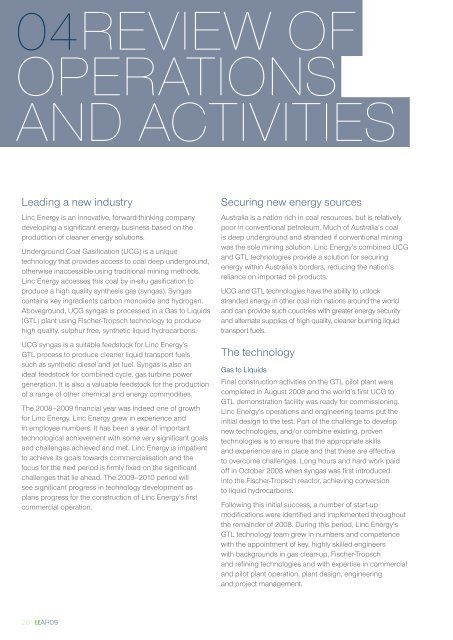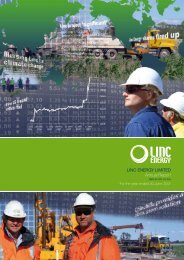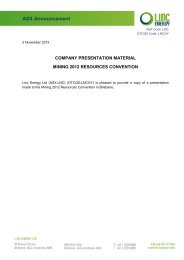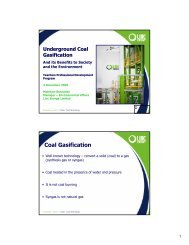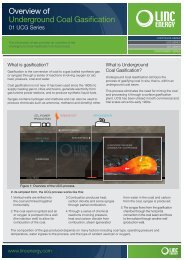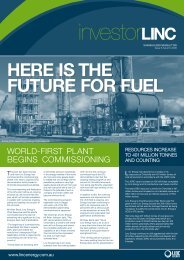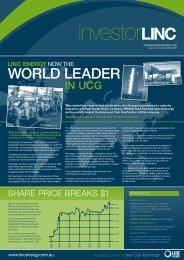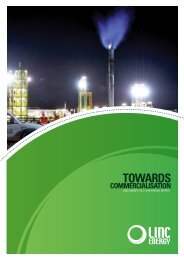LINC ENERGY LTD // 2009 ANNUAL REPORT
LINC ENERGY LTD // 2009 ANNUAL REPORT
LINC ENERGY LTD // 2009 ANNUAL REPORT
You also want an ePaper? Increase the reach of your titles
YUMPU automatically turns print PDFs into web optimized ePapers that Google loves.
04REVIEW OF<br />
OPERATIONS<br />
AND ACTIVITIES<br />
Leading a new industry<br />
Linc Energy is an innovative, forward-thinking company<br />
developing a significant energy business based on the<br />
production of cleaner energy solutions.<br />
Underground Coal Gasification (UCG) is a unique<br />
technology that provides access to coal deep underground,<br />
otherwise inaccessible using traditional mining methods.<br />
Linc Energy accesses this coal by in-situ gasification to<br />
produce a high quality synthesis gas (syngas). Syngas<br />
contains key ingredients carbon monoxide and hydrogen.<br />
Aboveground, UCG syngas is processed in a Gas to Liquids<br />
(GTL) plant using Fischer-Tropsch technology to produce<br />
high quality, sulphur free, synthetic liquid hydrocarbons.<br />
UCG syngas is a suitable feedstock for Linc Energy’s<br />
GTL process to produce cleaner liquid transport fuels<br />
such as synthetic diesel and jet fuel. Syngas is also an<br />
ideal feedstock for combined cycle, gas turbine power<br />
generation. It is also a valuable feedstock for the production<br />
of a range of other chemical and energy commodities.<br />
The 2008–<strong>2009</strong> financial year was indeed one of growth<br />
for Linc Energy. Linc Energy grew in experience and<br />
in employee numbers. It has been a year of important<br />
technological achievement with some very significant goals<br />
and challenges achieved and met. Linc Energy is impatient<br />
to achieve its goals towards commercialisation and the<br />
focus for the next period is firmly fixed on the significant<br />
challenges that lie ahead. The <strong>2009</strong>–2010 period will<br />
see significant progress in technology development as<br />
plans progress for the construction of Linc Energy’s first<br />
commercial operation.<br />
Securing new energy sources<br />
Australia is a nation rich in coal resources, but is relatively<br />
poor in conventional petroleum. Much of Australia’s coal<br />
is deep underground and stranded if conventional mining<br />
was the sole mining solution. Linc Energy’s combined UCG<br />
and GTL technologies provide a solution for securing<br />
energy within Australia’s borders, reducing the nation’s<br />
reliance on imported oil products.<br />
UCG and GTL technologies have the ability to unlock<br />
stranded energy in other coal rich nations around the world<br />
and can provide such countries with greater energy security<br />
and alternate supplies of high quality, cleaner burning liquid<br />
transport fuels.<br />
The technology<br />
Gas to Liquids<br />
Final construction activities on the GTL pilot plant were<br />
completed in August 2008 and the world’s first UCG to<br />
GTL demonstration facility was ready for commissioning.<br />
Linc Energy’s operations and engineering teams put the<br />
initial design to the test. Part of the challenge to develop<br />
new technologies, and/or combine existing, proven<br />
technologies is to ensure that the appropriate skills<br />
and experience are in place and that these are effective<br />
to overcome challenges. Long hours and hard work paid<br />
off in October 2008 when syngas was first introduced<br />
into the Fischer-Tropsch reactor, achieving conversion<br />
to liquid hydrocarbons.<br />
Following this initial success, a number of start-up<br />
modifications were identified and implemented throughout<br />
the remainder of 2008. During this period, Linc Energy’s<br />
GTL technology team grew in numbers and competence<br />
with the appointment of key, highly skilled engineers<br />
with backgrounds in gas clean-up, Fischer-Tropsch<br />
and refining technologies and with expertise in commercial<br />
and pilot plant operation, plant design, engineering<br />
and project management.<br />
By following a systematic approach to troubleshooting,<br />
stable and reliable operation of the synthesis gas cleaning<br />
and compression systems was achieved. This enabled<br />
the team to focus on comparing actual plant performance<br />
against design values, evaluate optimisation opportunities<br />
in contaminant removal and to gather important information<br />
during sustained periods of UCG to GTL operation to fully<br />
understand the integration of the two technologies. During the<br />
first two quarters of <strong>2009</strong>, four Fischer-Tropsch campaigns<br />
were conducted. Each campaign brought incremental<br />
improvement and learning. Linc Energy’s research laboratory<br />
contributed significantly to campaign success by operating<br />
a small scale Fischer-Tropsch reactor while simultaneously<br />
operating the main reactor of the pilot plant on identical UCG<br />
syngas. The laboratory reactor was able to demonstrate high<br />
carbon monoxide and hydrogen conversions over extended<br />
periods using gas taken from the plant. This provided not<br />
only valuable data but also significant confidence that further<br />
process improvement could be achieved.<br />
These achievements, coupled with advances in gas cleanup<br />
through continuous liaison with catalyst and chemical<br />
suppliers, enabled the GTL team to produce even higher<br />
quality syngas with contaminants in the parts per billion<br />
(ppb) range. The subsequent improved performance of<br />
the Fischer-Tropsch reaction section resulted in the production<br />
of appreciable quantities of high quality syncrude during<br />
these campaigns.<br />
The next stage of improvement work will focus on increasing<br />
catalyst activity, and subsequently, production rates. Work to<br />
further improve the Fischer-Tropsch catalyst reduction system<br />
is well under way and a program of Fischer-Tropsch catalyst<br />
options and performance testing (both in-house and external)<br />
is being expanded. Refinements and improvements in the UCG<br />
process, as a result of integrated pilot plant campaigns, have<br />
been implemented in the next generation pilot gasifier, which<br />
is nearing design completion.<br />
The results from the pilot work have and will continue to be<br />
used as key inputs during conceptual engineering of the<br />
commercial scale UCG to GTL facility. Since the beginning<br />
of <strong>2009</strong>, the GTL technology team has been working on the<br />
scope for the conceptual project and compiling the design<br />
basis for Linc Energy’s 20,000 barrel per day commercial<br />
UCG to GTL facility planned for South Australia. The team has<br />
also evaluated key Australian-based engineering companies<br />
to assist in Linc Energy’s GTL technology development.<br />
A technology partner selection process resulted in Linc Energy<br />
partnering with Aker Solutions to complete the conceptual<br />
design package by the end of the first quarter of 2010.<br />
Underground Coal Gasification<br />
Linc Energy made a significant investment during the year to<br />
further develop its UCG technology platform. The investment,<br />
largely in the form of a greatly expanded technology team,<br />
resulted in the acceleration of Linc Energy’s UCG technology<br />
development. This will further drive Linc Energy towards<br />
commercialisation as its technologies reach maturity.<br />
The UCG technology platform being developed is multidisciplinary.<br />
It links generator cavity growth modelling with<br />
gasification modelling and engineering, which in turn is<br />
linked with geological and hydrogeology understanding and<br />
modelling. The technology will allow Linc Energy to predict<br />
the volume, quality and cost of synthesis gas (and contained<br />
energy) produced from coal resources as they are identified.<br />
This platform will also be used as the basis for design,<br />
construction and operation of commercial UCG generators.<br />
The Linc Energy technology team is also developing the<br />
drilling, well design and other specialist engineering aspects<br />
of the technology to confirm cost and reliability objectives<br />
for commercial scale operations.<br />
26 27


